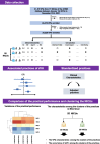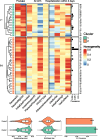The performance of the practices associated with the occurrence of severe intraventricular hemorrhage in the very premature infants: data analysis from the Chinese neonatal network
- PMID: 38877528
- PMCID: PMC11179376
- DOI: 10.1186/s12887-024-04664-8
The performance of the practices associated with the occurrence of severe intraventricular hemorrhage in the very premature infants: data analysis from the Chinese neonatal network
Abstract
Background: The occurrence of severe intraventricular hemorrhage (sIVH) was high in the very preterm infants (VPIs) in China. The management strategies significantly contributed to the occurrence of sIVH in VPIs. However, the status of the perinatal strategies associated with sIVH for VPIs was rarely described across the multiple neonatal intensive care units (NICUs) in China. We aim to investigate the characteristics of the perinatal strategies associated with sIVH for VPIs across the multiple NICUs in China.
Methods: This was a retrospective analysis of data from a prospective cohort of Chinese Neonatal Network (CHNN) dataset, enrolling infants born at 24+0-31+6 from 2019 to 2021. Eleven perinatal practices performed within the first 3 days of life were investigated including antenatal corticosteroids use, antenatal magnesium sulphate therapy, intubation at birth, placental transfusion, need for advanced resuscitation, initial inhaled gas of 100% FiO2 in delivery room, initial invasive respiratory support, surfactant and caffeine administration, early enteral feeding, and inotropes use. The performances of these practices across the multiple NICUs were investigated using the standard deviations of differences between expected probabilities and observations. The occurrence of sIVH were compared among the NICUs.
Results: A total of 24,226 infants from 55 NICUs with a mean (SD) gestational age of 29.5 (1.76) and mean (SD) birthweight of 1.31(0.32) were included. sIVH was detected in 5.1% of VPIs. The rate of the antenatal corticosteroids, MgSO4 therapy, and caffeine was 80.0%, 56.4%, and 31.5%, respectively. We observed significant relationships between sIVH and intubation at birth (AOR 1.52, 95% CI 1.13 to 1.75) and initial invasive respiratory support (AOR 2.47, 95% CI 2.15 to 2.83). The lower occurrence of sIVH (4.8%) was observed corresponding with the highest utility of standard antenatal care, the lowest utility of invasive practices, and early enteral feeding administration.
Conclusions: The current evidence-based practices were not performed in each VPI as expected among the studied Chinese NICUs. The higher utility of the invasive practices could be related to the occurrence of sIVH.
Keywords: Multiple neonatal intensive care units; Practice; Prematurity; Severe intraventricular hemorrhage.
© 2024. The Author(s).
Conflict of interest statement
The authors declare no competing interests.
Figures




Similar articles
-
Assessment of Neonatal Intensive Care Unit Practices, Morbidity, and Mortality Among Very Preterm Infants in China.JAMA Netw Open. 2021 Aug 2;4(8):e2118904. doi: 10.1001/jamanetworkopen.2021.18904. JAMA Netw Open. 2021. PMID: 34338792 Free PMC article.
-
Association between Neonatal Outcomes and Admission Hypothermia among Very Preterm Infants in Chinese Neonatal Intensive Care Units: A Multicenter Cohort Study.Am J Perinatol. 2024 Dec;41(16):2298-2307. doi: 10.1055/s-0044-1786873. Epub 2024 May 27. Am J Perinatol. 2024. PMID: 38802079 Free PMC article.
-
[Outcomes and care practices of extremely preterm infants at 22-25 weeks' gestation age from the Chinese Neonatal Network].Zhonghua Er Ke Za Zhi. 2024 Jan 2;62(1):22-28. doi: 10.3760/cma.j.cn112140-20231017-00296. Zhonghua Er Ke Za Zhi. 2024. PMID: 38154973 Chinese.
-
Interventions to Reduce Severe Brain Injury Risk in Preterm Neonates: A Systematic Review and Meta-analysis.JAMA Netw Open. 2023 Apr 3;6(4):e237473. doi: 10.1001/jamanetworkopen.2023.7473. JAMA Netw Open. 2023. PMID: 37052920 Free PMC article.
-
Evidence base multi-discipline critical strategies toward better tomorrow for very preterm infants.Pediatr Neonatol. 2020 Aug;61(4):371-377. doi: 10.1016/j.pedneo.2020.01.005. Epub 2020 Jan 25. Pediatr Neonatol. 2020. PMID: 32201157 Review.
References
Publication types
MeSH terms
Substances
Grants and funding
LinkOut - more resources
Full Text Sources

